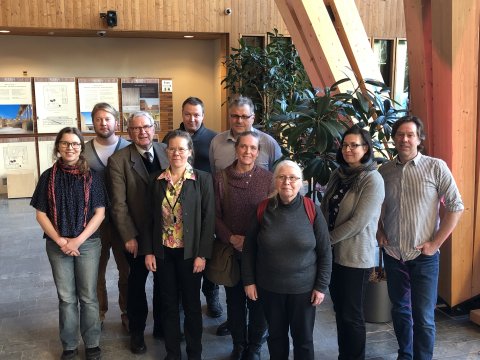The fourth Finnish AFINET workshop was held on 26 February in Joensuu. Michael den Herder, the Innovation Broker of the Finnish AFINET stakeholder network says that agroforestry starts gaining interest in Finland too. The presentations during the first part of the day showed how additional income can be gained from the cultivation of stinging nettle Urtica dioica, American gingseng Panax quinquefolium, mushrooms and hops Humulus lupulus. In the second part of the workshop, the participants could develop their ideas for creating new EIP-Agri Operational groups testing new innovations.
Stinging nettle and gingseng cultivation are both still in the experimental phase in Finland but Bertalan Galambosi’s experiments have shown that they could be very promising innovations in Finland. Stinging nettle fibres can be used for the production of eco-textiles but also in food preparation as a replacer of for example spinach. It can be grown in forest under trees, as well as in intercropping systems and open fields.
Ginseng is a very valuable medicinal plant and a small box of Ginseng can cost about 25 euros. Globally, China and the USA are the largest producers. Bertalan’s experiments have shown that Ginseng also grows well in Finland. The plant grows best in a semi-shaded environment. It can be cultivated in forests as well as in fields. When grown in fields the plants need to be covered by a roof or a net. Therefore, production under a tree canopy such as in a forest is interesting.
Mushroom cultivation was quite popular in the 1970’s but after that it gradually disappeared. Research on mushroom cultivation in laboratories of for example shiitake mushrooms started in the 1980’s. After that there has been some efforts on business development, but only very recently mushroom cultivation started to become more popular again in Finland. There are good opportunities for farmers and forest owners to gain additional income from mushroom cultivation in forests. In the workshop, Henri Vanhanen gave an overview of cultivation techniques for different mushroom species (shiitake, pakuri, reishi). Most of these techniques are quite simple and require relatively small investments on special equipment. It is however important to get good information and advice before you start. Since there is a large variety of edible mushrooms, it is possible to plan a mushroom forest providing an income throughout the entire growing season.
Hops cultivation has a long history in Finland. Finnish hop production peaked in the 1800’s and the hop varieties currently found in Finland are a relict from the olden days. Nowadays, USA, Germany and Czech Republic are the largest hop producers globally. There is a global trend of an increasing popularity of local micro-breweries so there is a demand for special hops. Currently local micro-breweries are booming but there are no growers of special hops in Finland. In her presentation, Susanne Heiska told that the Natural Resources Institute Finland and other research partners around the country are currently running several projects trying to speed up this process. Currently, in several multi-actor projects with local breweries, suitable hop varieties have been identified and are tested. The main bottlenecks now are to propagate enough healthy seedling material, the control of pests and diseases, high initial investment costs and find farmers willing to cultivate hops. But maybe the biggest bottleneck is the lack of suitable equipment to enable small-scale mechanical harvesting. Another solution could be to scale-up the production of small-scale hobby farmers but that’s also not easy. At the moment, there are more questions than answers but the research on hop cultivation is promising and continues…












